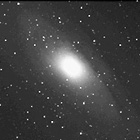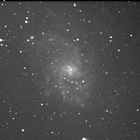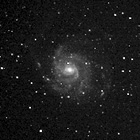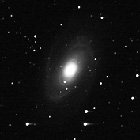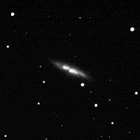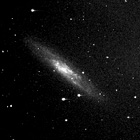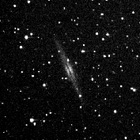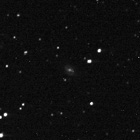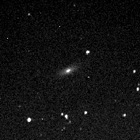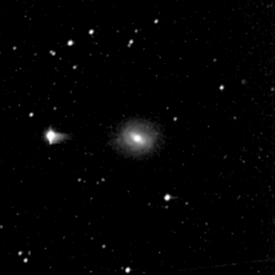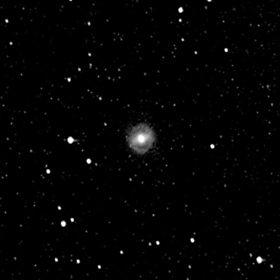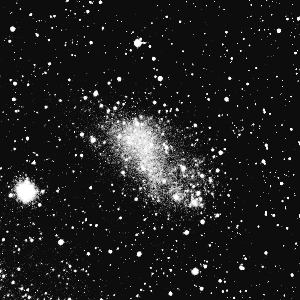Choose Target → Adjust Settings → Provide Information → Submit
Back to Thumbnail View
Galaxies & Beyond
Andromeda Galaxy
- Object Type: Galaxy
- Distance: 2 million light years
- Constellation: Andromeda
The closest large spiral galaxy, Andromeda is the sister galaxy to our Milky Way. Both are gravitationally bound to each other, and are moving closer together at 3 million miles an hour. In about four billion years time, they may collide and merge to form one super-galaxy! In your OWN observation of the Andromeda Galaxy, see if you can distinguish the dust lanes that divide the spiral arms.
Explore more NASA images of Andromeda Galaxy with Astropix
Whirlpool Galaxy
- Object Type: Galaxy
- Distance: 37 million light years
- Constellation: Canes Venatici
A beautiful face-on spiral galaxy, the Whirlpool's spiral pattern was first seen and sketched in 1845. At first, it was unclear whether astronomers were looking at a whole city of stars a long way off, or simply one nearby star and its newly formed planetary system. In your OWN image of the Whirlpool, can you see the small companion galaxy that is interacting with the larger spiral?
Explore more with NASA's Spitzer Space Telescope
Messier 33
- Object Type: Galaxy
- Distance: 3 million light years
- Constellation: Triangulum
M33 is a nearby spiral galaxy, and along with the Andromeda Galaxy and our own Milky Way, is one of the major members of our local group of around 35 galaxies. Even though M33 is very close to us, its spiral arms are quite faint. How much detail can you bring out in your OWN image?
Explore more with NASA's Swift satellite
Pinwheel Galaxy
- Object Type: Galaxy
- Distance: 27 million light years
- Constellation: Ursa Major
A face-on spiral galaxy a little larger than our own Milky Way galaxy, the Pinwheel is one of the bluest galaxies known, which means it is filled with young hot stars. In your OWN image of the Pinwheel Galaxy, can you see the lumpy knots in the spiral arms that are the vast star-forming regions? Close-up, these would look like the Eagle or Orion nebulas in our Milky Way. Take your OWN images of these objects too!
Explore more with NASA's Chandra X-ray telescope
Centaurus A
- Object Type: Galaxy
- Distance: 14 million light years
- Constellation: Centaurus
Centaurus A is a strange looking galaxy with a dark secret. In your OWN image of Cen A, can you find the dust lane across the face of the galaxy? This is the remnant of a spiral galaxy that collided with Centaurus A millions of years ago. The collision provided lots of gas and dust as food for a giant black hole at the center of Cen A, which is now feeding voraciously. To expose the hidden heart of this galaxy, you need a telescope that detects X-ray light. Compare your OWN image of Cen A to the one taken by NASA's Chandra X-ray Observatory.
Explore more with NASA's Chandra X-ray telescope

Messier 81
- Object Type: Galaxy
- Distance: 12 million light years
- Constellation: Ursa Major
M81 is perhaps the most perfect spiral galaxy in the night sky. With its elegant and symmetrical spiral arms, M81 shines with the light of 250 billion suns. Despite its apparent tranquility, M81 is locked in a destructive gravitational dance with its neighbor, M82. The gravitational push and pull would have triggered new outbreaks of star formation in M81, causing it to glow brilliantly. Using your OWN images, how would you compare the brightness of M81 to that of other galaxies?
Explore more with NASA's Astronomy Picture of the Day
Messier 82 (Cigar Galaxy)
- Object Type: Galaxy
- Distance: 12 million light years
- Constellation: Ursa Major
M82 is nicknamed the Cigar Galaxy. Its distorted shape is due to its proximity to its glamorous twin, M81. The gravity of M81 has twisted and distorted M82, turning it into a "starburst galaxy." Inside vast choking dust clouds, thousands of giant hot stars are being made, and the winds generated by the white-hot stars are blowing fountains of gas out of the galaxy. As new stars are born, other giant stars are dying in supernova explosions, making the Cigar Galaxy a spectacular cosmic firecracker! What do you see more of in your OWN image—hot, glowing gas, or dark, shadowy dust clouds?
Explore more with NASA's Chandra X-ray telescope
NGC 253 (Sculptor Galaxy)
- Object Type: Galaxy
- Distance: 11 million light years
- Constellation: Sculptor
The Sculptor Galaxy is a nearby spiral galaxy, first discovered in 1783 by astronomer Caroline Herschel while she searched for comets. The true nature of the Sculptor, as a city of billions of stars, was not confirmed for another 150 years. Because it is oriented almost edge-on to us, it is difficult to make out the spiral structure. What details can you bring out in your OWN image?
Explore more with NASA's Hubble Space Telescope
3C 273
- Object Type: Quasar
- Distance: 2 billion light years
- Constellation: Virgo
While it looks like an ordinary star (hence its name, quasi-stellar object, or quasar), 3C273 is actually a distant galaxy with a giant black hole at its core. The feeding black hole is so luminous that it shines brighter than a trillion suns. In fact, 3C273 is one of the brightest objects in the universe. Your OWN image of 3C273 may seem less impressive than of other objects, but remember: the light you have collected started its journey when life on Earth was nothing but bacteria!
Explore more with NASA's Chandra X-ray telescope
NGC 891
- Object Type: Galaxy
- Distance: 27 million light years
- Constellation: Andromeda
NGC 891 is a spiral galaxy seen perfectly edge-on. Our own Milky Way galaxy would probably look very similar to NGC 891 if we could move outside it and view it from the side. From our home inside the spiral arms of the Milky Way, dark, dusty clouds block our view of the galactic center. In your OWN image of NGC 891, can you see a dust lane running right down the middle of the disc?
Explore more with NASA's Hubble Space Telescope
NGC4013
- Object Type: Galaxy
- Distance: 55 million light years
- Constellation: Ursa Major
NGC 4013 is a spiral galaxy seen perfectly edge-on. From this orientation, it is difficult to get a clear idea of the structure of the spiral arms. Compare your OWN image of NGC 4013 with that of NGC 891. Why do you think one edge-on galaxy appears smaller than the other?
Explore more with NASA's Hubble Space Telescope
NGC2543
- Object Type: Galaxy
- Distance: 107 million light years
- Constellation: Lynx
NGC 2543 is a barred spiral galaxy, seen almost face-on. The bar shape appears in about half of spiral galaxies, and may be due to the particular movements of stars and gas within a rotating spiral galaxy, or an interaction with another galaxy. In your OWN image of NGC 2543, can you make out the smooth "S" shape of the bar and arms?
See an image of NGC 2543 from the Sloan Digital Sky Survey
NGC4124
- Object Type: Galaxy
- Distance: 73 million light years
- Constellation: Virgo
NGC 4124 is a lenticular (lens-shaped) galaxy. It has a disc, like spiral galaxies, but little or no gas and dust, like elliptical galaxies. Without the gas and dust, the galaxy has no raw material for making new stars. As the short-lived hot stars die off, galaxies such as NGC 4124 are left with an aging population of orange-red stars. In your OWN image, would you describe NGC 4124 as more like a spiral galaxy, or an elliptical galaxy?
See an image of NGC 4124 from the Sloan Digital Sky Survey
Messier 87
- Object Type: Galaxy
- Distance: 60 million light years
- Constellation: Virgo
M87 is one of the biggest galaxies in the universe—a cosmic blue whale that sits at the center of the nearest galactic supercluster. When you look at your OWN image of this galaxy, you are looking at an object that shines with the light of a trillion stars! Not only is M87 one of the biggest galaxies observed, it is host to one of the biggest black holes known. With a mass of three billion Suns, M87's black hole is the size of an entire solar system!
Explore more with NASA's Hubble Space Telescope
Messier 58 (NGC 4579)
- Object Type: Galaxy
- Distance: 68 million light years
- Constellation: Virgo
M58 (also called NGC 4579) is a barred spiral galaxy and member of Virgo cluster of galaxies. A barred spiral has an elongated nucleus, a feature that is found in about half of spiral galaxies, including our Milky Way. The cause of the bar is still not clear, but may be caused by an interaction with another galaxy. Can you see the bar shape of the nucleus in your OWN image of M58?
Explore more with NASA's Spitzer Space Telescope
Messier 95 (NGC 3351)
- Object Type: Galaxy
- Distance: 32.6 ± 1.4 million light years
- Constellation: Leo
Messier 95 is a barred spiral galaxy, meaning it has spiraling arms that stretch outward from a dense central bar of stars. One feature that distinguished M95 is its inner ring of stars that surrounds the central bar. This inner ring hosts several star forming regions, some that could grow into globular clusters. M95 gained a lot of attention in 2012 when astronomers observed a supernova in one of the arms.
Explore more with NASA's Astronomy Picture of the Day
Phantom Galaxy (NGC 628)
- Object Type: Galaxy
- Distance: 30 ± 6 light years
- Constellation: Pisces
Messier 74 is also known as the Phantom Galaxy, perhaps because it's one of the dimmer galaxies at optical wavelengths. M74 is almost nearly perfectly face-on from our perspective on Earth, making it an amazing target to study the characteristics of spiral galaxies. This galaxy has been estimated to have about 100 billion stars, which is a lot, but still less than the number of stars in our Milky Way. Multiple supernova have been observed in M74 over the last few decades, which have helped to estimate how far away the galaxy is - approximately 30 million light years.
Explore more with NASA's Hubble Space Telescope
Large Magellanic Cloud
- Object Type: Galaxy
- Distance: 163000 light years
- Constellation: Dorado
Don't be misled by the word Cloud in the name of this cosmic object - the Large Magellanic Cloud (LMC) is a galaxy. It is one of the largest galaxies in our local group, yet current measurements indicate it has only one-tenth the mass of the Milky Way. The LMC is an irregular galaxy, and like many irregular galaxies (like M82, another MicroObservatory target), the LMC is experiencing a very high rate of star formation. The LMC is one of our closest galactic neighbors, and is projected to collide with the Milky Way in 2.5 billion years. What do you think you'd see in the sky when that happens?
Explore more with the European Southern Observatory's VISTA Telescope
Small Magellanic Cloud
- Object Type: Galaxy
- Distance: 200000 light years
- Constellation: Tucana
The Small Magellanic Cloud (SMC) is a dwarf irregular galaxy. It has a bar structure at its core, so some astronomers imagine that it was once barred spiral galaxy like NGC2543. As a result of influence from the Milky Way though, the common spiral shape deformed into the irregular galaxy we see today. The SMC happens to be one of the closest galaxy neighbors to us, which also makes it one of the most distant objects that you can see from Earth with your naked eye. If you are in the Southern Hemisphere look for it sometime - do you see the bridge that connects the SMC to the Large Magellanic Cloud?
Explore more with NASA's Spitzer Space Telescope
Whale Galaxy (NGC 55)
- Object Type: Galaxy
- Distance: 6.5 million light years
- Constellation: Sculptor
The Whale Galaxy is a barred spiral galaxy, much like the Milky Way, and half of all spiral galaxies. We see the Whale Galaxy edge on, sort of like seeing a frisbee from the side. This galaxy has an active star forming region, and has formed a number of huge stars that burn hydrogen fast over a relatively short life. So many of these stars have exploded as supernovae that x-ray imaging can see gas that has blown out from the flat disk of the galaxy. The Whale Galaxy has a companion galaxy NGC 4627 just above its back, do you see it in your MicroObservatory image?
Explore more with NASA's Astronomy Picture of the Day

NGC 4945
- Object Type: Galaxy
- Distance: 11.7 million light years
- Constellation: Centaurus
NGC 4945 might seem pretty similar to the Milky Way at first, because they are both spiral barred galaxies, and are estimated to be about the same size. However, what sets NGC 4945 apart is that it is categorized as a Seyfert Galaxy. This means that it has an active galactic nucleus, most likely holding a supermassive black hole. It would look similar to the Milky Way at a glance, but other wavelengths show that the core of NGC 4945 is producing energy far greater than a calm galaxy like ours.
Explore more with NASA's Astronomy Picture of the Day

Southern Pinwheel Galaxy (NGC 5236)
- Object Type: Galaxy
- Distance: 14.7 million light years
- Constellation: Hydra
This magnificent galaxy is seen nearly face on, and is one of the closest barred spiral galaxies to Earth, making it visible in the night sky with a pair of binoculars. As a result, the Southern Pinwheel Galaxy gives us a great view to so much of what galaxies have to offer: hundreds of thousands of stars, thousands of star clusters, and hundreds of supernova remnants. We can see lots of active star formation along the edges of the dust lanes, the product of supernova explosions returning their material to make the next generation of stars.
Explore more with NASA's Hubble Space Telescope



